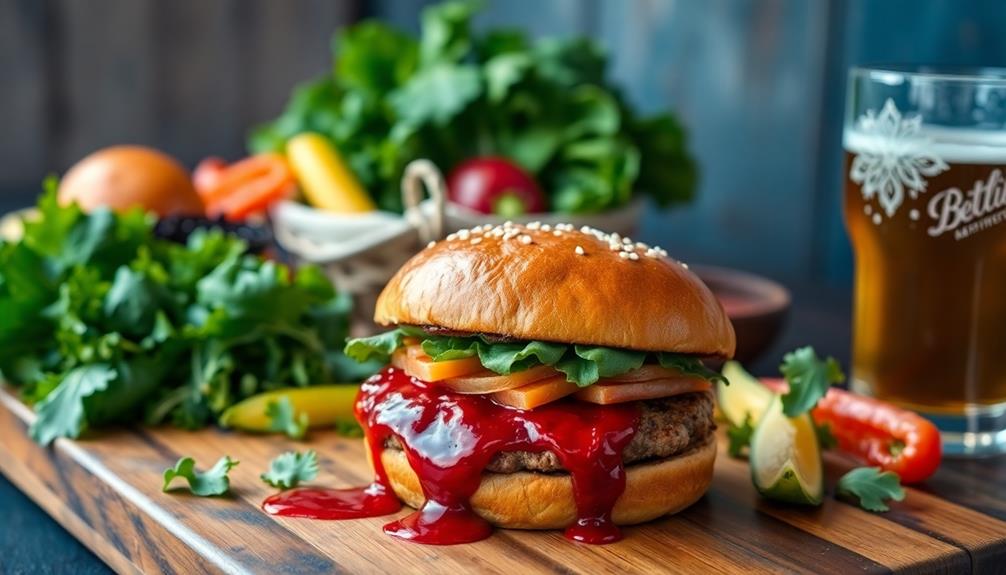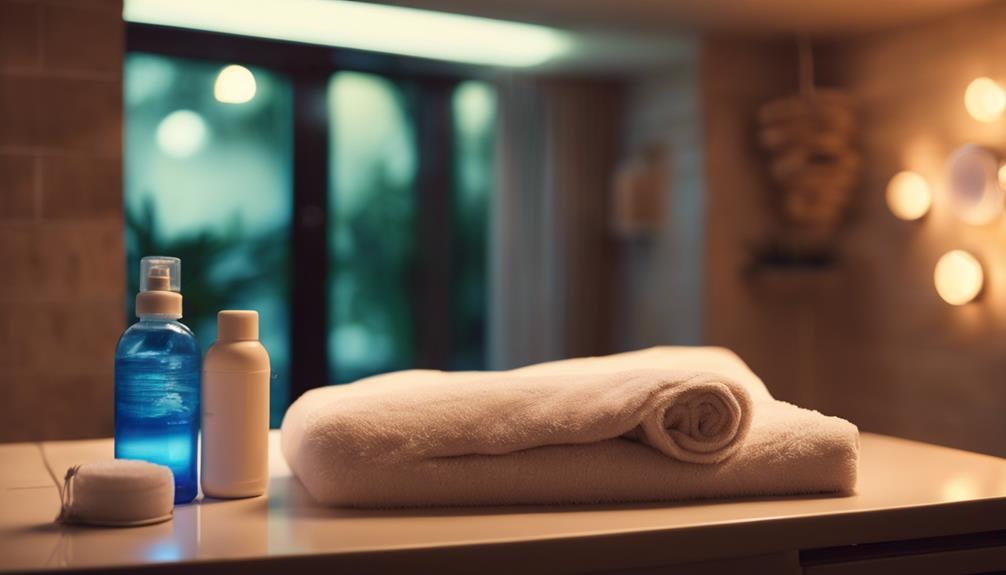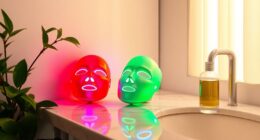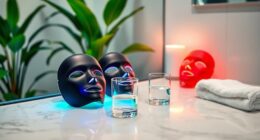Tanning can leave you looking pale because of skin damage and uneven fading. When your skin peels or loses moisture, it can create a lighter appearance, especially if you have lighter skin that produces less melanin. Genetics and overall skin health also play a role in how your tan holds up. If you don't exfoliate regularly, you might notice patchiness as the tan fades. Additionally, environmental factors, like exposure to UV rays, can deepen your tan, while others might limit it. If you want to explore how to maintain a beautiful tan effectively, you might find some helpful tips ahead.
Key Takeaways
- Peeling skin after tanning can lead to uneven fading, making the skin appear pale in certain areas.
- Lighter skin types produce less melanin, resulting in a less pronounced tan that may look faded.
- Overexposure to UV rays can damage skin cells, leading to premature aging and a dull appearance, which may seem pale.
- Inconsistent tanning habits, such as neglecting exfoliation or moisturizing, can create patchiness and an overall pale look.
Skin Reactions and Variability
Everyone's skin reacts differently to tanning, so you'll notice variations in how long your tan lasts and how quickly it fades. Your unique skin type plays a significant role in how well your skin retains that sun-kissed glow.
If your skin tends to peel, you might find your tan fading faster than someone with more resilient skin. Genetics and overall skin health also influence your tanning experience; lighter skin typically produces less melanin, making it trickier to achieve a deep tan.
Regular exfoliation can accelerate the return to your natural skin tone, while not taking care of your skin can lead to uneven fading. Understanding these factors helps you manage your tanning results better and maintain a more consistent look.
The Science of Melanin
Melanin production plays an essential role in determining how your skin tans and protects itself from UV damage. When you expose your skin to sunlight, melanocytes generate melanin, which absorbs harmful UV rays. Here's what you need to know about melanin and tanning:
- Skin Type Matters: Different skin types produce varying amounts of melanin, affecting how easily you tan.
- Protection Mechanism: Melanin acts as a natural shield, helping to prevent sunburn and skin damage.
- Hormonal Influence: Factors like hormones can impact your melanin production during tanning.
- Temporary Effects: While tanning increases melanin, it fades over time, often leaving your skin looking paler than before.
Understanding melanin helps you appreciate its crucial role in your tanning experience.
Common Tanning Misconceptions
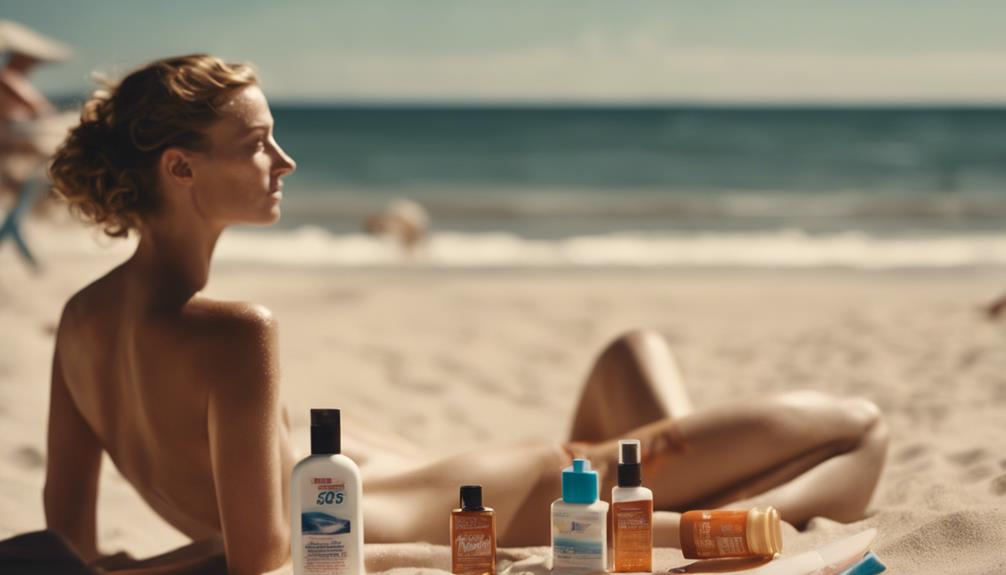
Many people believe myths about tanning that can lead to harmful practices and misconceptions about skin health.
One common myth is that you won't get sunburned on cloudy days. In reality, UV rays can still penetrate clouds, so sunscreen is essential.
Another misconception is that having a base tan protects you from sun damage; unfortunately, it doesn't provide adequate protection.
Many also think that the more sun exposure you get, the better your tan will be, but moderation is key to avoid skin damage.
Finally, some believe that tanning beds are safe, yet they still expose you to harmful UV rays.
Understanding these misconceptions promotes safer tanning practices and helps you maintain healthier skin.
Effective Tanning Techniques
Achieving a beautiful tan requires understanding effective techniques that enhance color while minimizing skin damage. Here are some tips to help you get that perfect glow:
- Exfoliate Before Tanning: Slough off dead skin cells to guarantee an even tan.
- Use Sunscreen: Protect your skin with a broad-spectrum SPF to prevent burns while allowing for a gradual tan.
- Limit Exposure: Gradually increase your sun exposure to avoid overdoing it and causing damage.
- Moisturize Regularly: Keep your skin hydrated post-tan to enhance color longevity and prevent peeling.
Environmental Influences on Tanning

The environment plays a significant role in how effectively you tan, affecting both the intensity and duration of your skin color. Factors like sunlight exposure, humidity, and altitude can impact your tanning results.
For instance, higher altitudes expose you to more UV rays, potentially deepening your tan. Conversely, cloudy or rainy days might limit your UV exposure, leading to a lighter tan.
Additionally, indoor lighting can create illusions of a better tan, while harsh shadows can reveal your true skin tone. Understanding these environmental influences helps you navigate your tanning journey more effectively, ensuring you achieve the desired results without compromising your skin's health.
Keep these factors in mind to make informed decisions about your tanning practices.
Tanning Habits and Skin Care
Establishing effective tanning habits and a solid skin care routine is essential for maintaining a healthy, long-lasting tan. To achieve this, consider these key practices:
- Moisturize daily: Hydrated skin retains color better and prevents peeling.
- Exfoliate regularly: This helps remove dead skin cells, promoting an even tan and preventing patchiness.
- Limit exposure: Moderation is important; overdoing it can lead to skin damage and a quicker fade.
- Use sunscreen: Protecting your skin from UV rays is imperative, even if you're aiming for a tan.
Risks of Overexposure to UV Rays

How can overexposure to UV rays jeopardize your skin health and increase the risk of serious conditions like skin cancer?
When you spend too much time in the sun or use tanning beds excessively, you damage your skin cells. This damage can lead to premature aging, such as wrinkles and age spots, making your skin appear older and paler over time.
More critically, overexposure raises your risk of skin cancer, including melanoma, the deadliest form. The harmful UV rays can also weaken your skin's natural defenses, making it more susceptible to infections.
To protect yourself, always use sunscreen, seek shade, and wear protective clothing.
Moderation is key to enjoying a tan without jeopardizing your health.
Frequently Asked Questions
How Does Hydration Affect the Appearance of a Tan?
Hydration greatly affects your tan's appearance. When you're well-hydrated, your skin looks plump and radiant, enhancing your tan. Conversely, dehydrated skin can appear dull and flaky, making your tan look uneven and less vibrant.
Can Diet Influence My Skin's Tanning Ability?
Your diet impacts your skin's tanning ability—nutrient-rich foods boost melanin production, while hydration helps maintain skin health. Eating antioxidants and healthy fats supports your glow, making your tan more vibrant and lasting.
Do Specific Skincare Products Enhance or Diminish Tanning Results?
Certain skincare products can enhance or diminish tanning results. Moisturizers maintain hydration, helping your tan last longer, while exfoliants can speed up fading. Always choose products that complement your tanning goals for the best outcomes.
How Does Age Impact the Effectiveness of Tanning?
As you age, your skin's ability to tan fades like an old photograph losing its color. You'll notice melanin production slows, making it harder to achieve that sun-kissed glow you once had.
Can Stress Levels Affect My Skin's Ability to Tan?
Yes, stress levels can affect your skin's ability to tan. High stress may disrupt hormonal balance, impacting melanin production. When your body's under stress, it might struggle to maintain an even, lasting tan.
Conclusion
In your quest for that sun-kissed glow, remember the adage, 'Everything in moderation.'
By understanding your skin's reactions and embracing effective tanning techniques, you can achieve the bronzed look you desire without the risk of looking pale or unhealthy.
Don't ignore the importance of proper skin care and awareness of environmental factors.
With the right approach, you can enjoy a radiant complexion while keeping your skin safe and vibrant.
Embrace knowledge, and let your skin shine!




